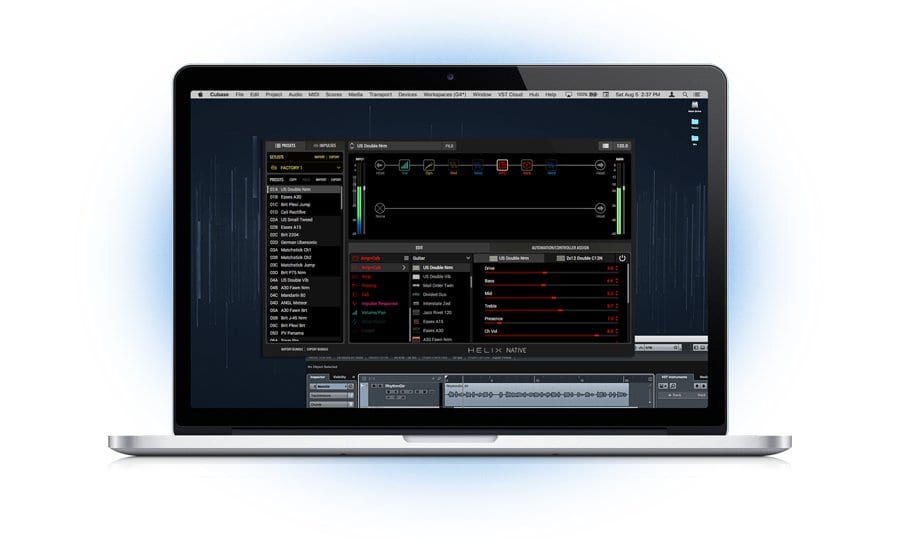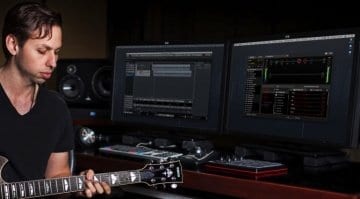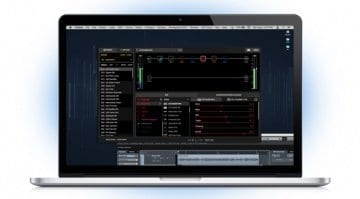Virtual Guitar Amp Software Round-up Part One: Line 6 Helix Native
In this series Jef covers the pros and cons of virtual amp software
Software virtual guitar amplifiers have come along way in recent years and we have put a few of the most popular ones to the test in our studio. This new series will cover the latest and greatest software amps, comparing their pros and cons and letting you make an informed choice on where to spend your money.
Part One
In this first post in the series, will be covering Line 6’s Helix Native. We also have Positive Grid’s BIAS Amp 2, Native Instrument’s Guitar Rig and IK Multimedia’s Amplitube lined up, along with some of the best freeware virtual amp modellers as well.
Software Stacks
Luckily for many of us guitarists in these modern times, you can get a good quality guitar sound for a pretty reasonable amount of money, unlike not so long ago when you needed to spend a fair amount recording by mic’ing up a good quality valve amp, crank it up and hire a recording engineer to capture it all on tape!
Well, I have been testing and comparing the current crop of virtual guitar amp software packages and here is a summary of some of the top software amp packages available in 2018.
Line 6 Helix Native
Having pioneered the virtual amp world with their ‘kidney bean’ shaped Pod back in the late ’90s, Line 6 has had plenty of time to develop virtual amps, cabinets and effects systems for us recording/gigging guitarists. The Helix Native takes this heritage bang up to date and is essentially the software heart of the Helix floor pedal system loaded up on your computer.
I’ve been running it on both my iMac and MacBook Pro under OSX via Logic Pro X as it requires a DAW to run, unlike a few of its competitors which can run standalone. The GUI is easy on the eye, clean and crisp, so easy to navigate which is a huge plus compared to a few of the other software packages I have tried over the years.
Considering their relatively long history making virtual models, the Helix Native does a pretty decent job of sounding good in a mix. There are plenty of amp/cab choices that covers most bases and also a good helping of effects to complement them.
Tones and Control
The Helix Native software comes with the usual set of patches that are based upon certain ‘signature sounds’ from various famous songs and players, they are named in such a way that it is easy to guess what they are alluding to, without naming the artist or song outright. Now, I would suggest that when starting out that you check a few of these presets out and see how the virtual signal chains are set up, then go on and build your own custom patches from scratch.
The interface lets you click and select from the various amp, cab and effects options, rather than using a ‘drag and drop’ interface. It is all very easy to use and if you have tried a Helix floor pedal it should make perfect sense to you. I own a Helix LT so this was familiar territory straight away, which I really enjoyed as I didn’t need to go reading manuals or getting frustrated with overly complex GUIs. The neat and simple layout is a huge bonus when using this plug-in in your DAW.
I found I could dial in pretty much any tone I needed and that there are more than enough built-in effects within Helix Native to create the tone I wanted. Of course, in Logic Pro X I could have added more effects anyway, but honestly, I didn’t need to at any point, as the Helix Native plug-in covers just about all bases for building quality guitar tones.
Value For Money?
Coming in at USD 399, Helix Native isn’t the cheapest virtual guitar amp software package on the market. In fact, in the selection we’re looking at, it’s the most expensive. Compare that price to its major competitors such as Native Instrument’s Guitar Rig 5 Pro which costs GBP 169.00 or Positive Grid’s BIAS Amp 2 at USD 299 for the Elite version and IK Multimedia’s Amplitube 4 Deluxe at EUR 359.99.
Pros and Cons
I would suggest that it is in my opinion very easy to use, has great sounds (and lots of them), more than enough effects and also can handle IRs (Impulse Responses, check out my article here on why this is important). Okay, it isn’t standalone and you will need a DAW to run it in, but for me, this is a prerequisite for recording anyway and therefore not a deal breaker.
You can of course always try out there 15-day demo version and see if you like the software and this is great. Plus Helix and Helix LT owners are entitled to a discounted price, which is handy as the hardware and software can share patches between the two with minimal fuss.
I loved the immediacy of the Helix Native, I think personally that the GUI is very user-friendly and most importantly it sounds great, sits well in a mix and allows you to emulate classic guitar rigs and build your own custom ones. If I had to rate it out of 10 then I would give it a 9/10 and only because of the lack of a standalone version, which I know some users would find
The recent 2.5 system update for the Helix hardware also carried over to Helix Native and it brought a lot of really cool effects and a couple of great boutique amp models as well, so I think the score I have given is fair. As this recent update added a lot of value and you didn’t pay for the ‘upgrade’ and all effects are included at no extra cost, so no tiered pricing unlike some of Helix Native competitors and free updates for existing users, which is always good.
For me, it comes down to ease of use, sound quality and support. I found that Line 6 has put a lot into the Helix Native plugin, making it feel slick with plenty of useful options and it feels like a professional piece of software straight away, so I would recommend it as being good value for money for recording studios that need variety and quality sounds.
I would say that if you want it for live sounds then actually you would be better off buying a hardware version, so either Helix or Helix LT, as using a plug-in via an audio interface through a DAW loaded onto a computer isn’t perhaps the best scenario for live work, however you could buy Helix Native then for a discount and use it in the studio as well.
Helix Native is in the top tier pricing wise (unless you are eligible for a discount of course), yet I feel like the ‘free’ updates and also the quality of sounds means that Helix Native is still great value for money.
Available for Mac and Windows, 64-bit and runs via AU, VST and AAX
RRP – USD 399.99 and from USD 99.99 with a registered Helix Floor or Rack or USD 299.99 with a registered Helix LT
More Information
Video
You are currently viewing a placeholder content from YouTube. To access the actual content, click the button below. Please note that doing so will share data with third-party providers.
2 responses to “Virtual Guitar Amp Software Round-up Part One: Line 6 Helix Native”










my question is: how do you tame latency? Can you track thru?
Well, if your audio interface is running at a reasonable rate i.e 96 kHz, 48 kHz or below then it shouldn’t be an issue. I had no problems tracking through Logic Pro X with a standard M Audio 2x2M and that isn’t the exactly the best interface on the planet. Latency will depend more on your hardware setup, so check your system if you are experiencing latency issues, as I found Helix Native to be solid, very stable and it gave me no trouble at all. Hope that helps.